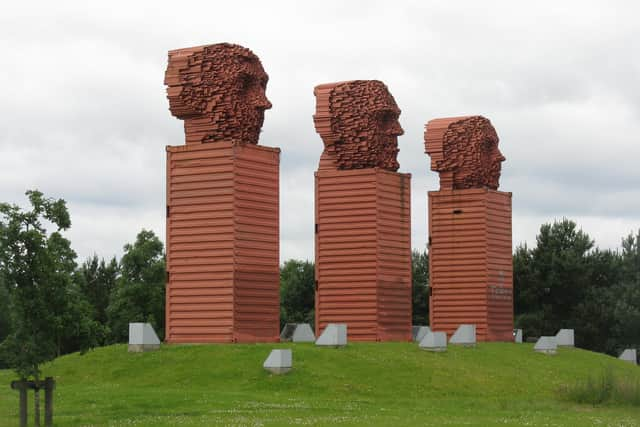Who or what are the ‘Big Heids’ along the M8 Motorway? Head sculptures on the A8 Trunk Road outside Holytown explained
and live on Freeview channel 276
If you’ve ever driven on the M8 through North Lanarkshire you’ll know doubt have wondered what those ‘Big Heids’ are all about - GlasgowWorld is here to explain everything you need to know about these three disembodied metal men.
You might think ‘Big Heids’ is a nickname given to the artwork by those that have passed it - but you’d be wrong, the official name of the art is just ‘Big Heids’. Made out of thousands of welded steel tubes - it pays homage to the proud industrial heritage of North Lanarkshire, specifically the Ravenscraig steel manufacturing plant and the Clydesdale Steel Works - the Mossend site that produced steel tubes incredibly similar to the ones used in the artwork.
Advertisement
Advertisement
The artwork is hard to miss - and marks the prominent landmark on the south side of the A8 trunk road, at the edge of the Eurocentral industrial distribution centre, just outside of Holytown. The three giant heads have stood at the spot since 1999 - which is a long enough time to wait to cross any road - although they can be forgiven as they’re 23 foot tall and weigh around 18 tons (they also don’t have any legs which further complicates the issue).
It’s hard to tell in passing - but the heids are actually propped up on the top of upturned shipping containers. A controversial work at it’s time, it cost around £273,000 and was a part of the ‘M8 sculpture corrider’ - a 90’s art project to make the road between Edinburgh and Glasgow a little more aesthetically interesting. The project was used as engineering training programme involving apprentices and adult trainees. The construction company was local engineering firm, Motherwell Bridge.
The sculptures were designed by Scottish sculptor David Mach - the faces were based on the faces of local volunteers - two men and one woman picked from random on the streets of Motherwell. They were reportedly dubbed Clara, Gerry and Brian by the teams building them, although it’s unclear if these were the names of the Motherwell locals.
The M8 art project scheme was the first ever substantial commitment to environmental motorway public art in Britain and sealed Scotland’s place as the European leader in the field. The Big Heids were the last sculpture to be erected - the project also saw the construction of the Heavy Horse in Glasgow Business Park, The Horn in Polkemmet Country Park, and the Sawtooth Ramps (or Pyramids) near Bathgate.


Advertisement
Advertisement
The Scottish Office supported the project in the early nineties and had already been involved in environmental improvements to the tune of £700,000 comprising newly-planted trees and landscaping. The idea behind the project was of artworks that were clearly visible and would allow drivers and passengers to see them without causing alarm or risking a safety hazard.
